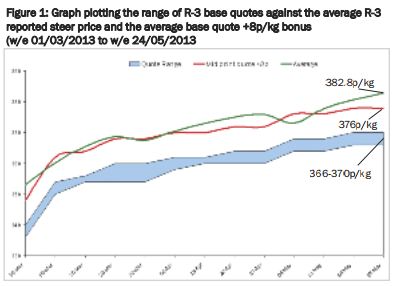



Higher Prices Available Than Base Quotes Suggest
NORTHERN IRELAND - Prime cattle prices are being worked out by using U-3 prices to align particular cattle to individual grades, a system in place since March 2011, write analysts at Livestock and Meat Commission Northern Ireland.Quotes from the processors this week for U-3 grade prime cattle were 374-380p/kg with an additional 8p/kg bonus available for steers and heifers that kill out within the desired specification. The quotes from the plants however should be viewed as a starting point for negotiation as higher prices are available than quotes would suggest.
Prime cattle are generally paid for on a pricing gridwhich uses the U-3 price to work out a relative value of other individual grades. The pricing grid was introduced in March 2011 and is subject to a series of penalties and bonuseswhichare outlined in Figures1 and 2. It is however worth noting that the quotes, the pricing grid and the associated bonuses and penalties are a rather notional arrangement and can show variation from plant to plant.
In practice the price paid for individual grades is driven by supply and demand issues andis open to much negotiation. Given the flexibility of the pricing system currently in place across the NI plants there are often marked differences in the quotes from the plants and the actual price paid.
Careful analysis of the price reporting data allows a comparison to be drawn between the prices being quoted by the plants and the prices they actually paid. For the purposes of this analysis we have examined the prices paid for 1,749 R-3 grade steers slaughtered in NI over the last 13 weeks.
These should, according to the pricing grid, be paid at 6p/kg below the U-3 base quote. Aberdeen Angus, Hereford and Organic cattle attract additional bonuses to those outlined in the tables so have not been included in this analysis to allow like for like analysis.
Figure 1 displays the range of quotes from the plants for the last 13 weeks for R-3 steers (blue band), the average quote plus the 8p/kg bonus available forin specR-3 steers (red line) and the actual price paid for all R-3 steers (green line).
If the quotes and8p/kg bonus payment were representative of the prices actually being paid then the green line indicating the average price paid should fall between the blue shaded area indicating quotes and the red line indicating the average quote plus the 8p/kg bonus. As outlined in Figure 1
this has not been the case during the last quarter with the exception of one week in early May.
This indicates that the plants have been paying higher prices than the quotes, pricing grid and
penalty and bonus system would suggest. While quotes have remained fairly steady over the last number of weeks the actual price being paid for R-3 steers has increased.
In the week ending the 24 May 2013 the average R-3 steer price was 382.8p/kg. This was 14.8p/kg higher than the average base quote of 368p/kg and 6.8p/kg higher than the average base quote plus the8p/kg bonus. It is worth noting that not all R-3 steers fulfilled all of the criteria for the 8p/kg bonus with 78.5 per cent qualifying in the week ending the 24 May 2013.
From this analysis it is possible to say that the top quote is a betterindication of what is actually being paid, but even it underestimates the deals that are available on the market.
It is therefore important that producers are aware that higher prices are available than initial quotes would suggest and they should shop around to get the best possible deal. This is particularly important given the difficult production conditions and increasing costs associated with beef production experienced in 2012/13.
The plants have been reporting a tightening in the availability of prime cattle in recent weeks, particularly in spec cattle, with indications that numbers could remain tight until the end of the summer. The prime kill last week totalled 6,928 head, 225 head fewer than the previous week.
Cow through put meanwhile remained strong with 1,852 head slaughtered. Throughput of prime cattle in NI during 2013 to date has totalled 139,519 head. This is anincrease of 4,625 head on the same period in 2012 when 134,894 headwere slaughtered (+3.5 per cent). This increased throughput of prime cattle however has not translated into more beef being processed due to a drop in average prime carcase weights of 11kg between the two periods.
TheCattleSite News Desk




